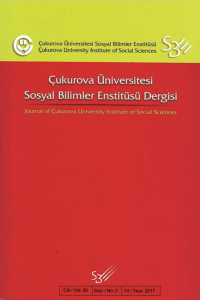Öz
In this study,
effects of economic development and migration on the crime rates are investigated
for the European Union countries. In the study, economic development level is
measured in terms of gross domestic product per capita in purchasing power parity (GDP per capita in PPP). Six
crime categories are considered; intentional homicides, rape, assault, sexual assault, theft and vandalism as a number of occurrences per hundred
thousand inhabitants of countries. Migration rate is measured as a percentage
of migrants of the total population per year. Data were obtained from Euro stat
database and covers 30 nations for the period of 2008-2013. In the study, we
first performed principal component analysis (PCA). The objective of the PCA is to determine the crime
factor scores which represent a crime levels as a whole for each of the
nations, and also to determine the important components of these crime factor
scores. Then, a cross-country regression analysis performed as
crime factor scores a dependent variable and economic development level and
migration rate as independent variables. Results show that, a significant
positive relation exists between the economic
development level and the crime factor scores. Also, high
migration rates don’t lead to higher
crime rates.
Anahtar Kelimeler
Kaynakça
- Duha T. A. (2012). Crime and unemployment: Evidence from Europe. International Review of Law and Economics. 32, 145– 157.
- Engelen, P.J., Lander, M.W. & Essen M. (2015). What determines crime rates? An empirical test of integrated economic and sociological theories of criminal behavior. The Social Science Journal (in press).
- Gould, E., Weinberg, B., and Mustard, D. (2002). Crime Rates and Local Labor Market Opportunities in the United States: 1979-97. Review of Economics and Statistics, 84(1), 45-61.
- Goulas, E. & Zervoyianni, A. (2015). Economic growth and crime: Is there an asymmetric relationship?. Economic Modelling. 49, 286–295.
- Hemley, D.D. & Mc Pheters L.R. (1975). Crime as an Externality of Economic Growth: An Empirical Analysis. The American Economist. Vol. 19, No. 1, 45-47.
- Khan,N., Ahmed, J., Nawaz, M. & Zaman, K. (2015). The Socio-Economic Determinants of Crime in Pakistan: New Evidence on an Old Debate. Arab Economics and Business Journal. 10, 73–81.
- Machin, S., and Meghir, C. (2004).Crime and Economic Incentives. Journal of Human Resources, 39(4), 959-79.
Öz
Kaynakça
- Duha T. A. (2012). Crime and unemployment: Evidence from Europe. International Review of Law and Economics. 32, 145– 157.
- Engelen, P.J., Lander, M.W. & Essen M. (2015). What determines crime rates? An empirical test of integrated economic and sociological theories of criminal behavior. The Social Science Journal (in press).
- Gould, E., Weinberg, B., and Mustard, D. (2002). Crime Rates and Local Labor Market Opportunities in the United States: 1979-97. Review of Economics and Statistics, 84(1), 45-61.
- Goulas, E. & Zervoyianni, A. (2015). Economic growth and crime: Is there an asymmetric relationship?. Economic Modelling. 49, 286–295.
- Hemley, D.D. & Mc Pheters L.R. (1975). Crime as an Externality of Economic Growth: An Empirical Analysis. The American Economist. Vol. 19, No. 1, 45-47.
- Khan,N., Ahmed, J., Nawaz, M. & Zaman, K. (2015). The Socio-Economic Determinants of Crime in Pakistan: New Evidence on an Old Debate. Arab Economics and Business Journal. 10, 73–81.
- Machin, S., and Meghir, C. (2004).Crime and Economic Incentives. Journal of Human Resources, 39(4), 959-79.
Ayrıntılar
| Bölüm | Makaleler |
|---|---|
| Yazarlar | |
| Yayımlanma Tarihi | 31 Ekim 2017 |
| Gönderilme Tarihi | 8 Kasım 2017 |
| Yayımlandığı Sayı | Yıl 2017 Cilt: 26 Sayı: 2 |


